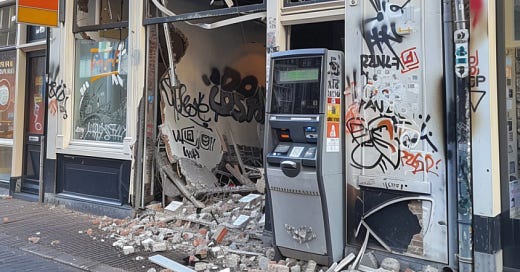Discussing The Rising Trend of ATM Bombings
The Rise of ATM Bombings: A New Wave of Criminal Activity in Germany
What drives criminal gangs to increasingly use explosives in their heists? Why has Germany become a hotspot for such brazen attacks? These questions arise in the wake of a disturbing trend in Europe: a surge in ATM bombings.
The recent wave of explosive attacks on cash machines across Germany highlights a growing and dangerous method employed by criminal gangs seeking quick financial gains.
The Alarming Trend of ATM Bombings
In Germany, a surge in ATM bombings has caught the attention of both law enforcement and the public. Criminal gangs have been targeting cash machines, using explosives to access the money stored inside. These attacks not only result in significant financial loss but also pose serious risks to public safety and property.
“The number of ATM burglaries involving explosives [In Germany] increased by 26.5% in 2022 over 2021, the most recent figures available, according to a joint statement by the interior and justice ministries published on Saturday. That’s the highest since surveys began in 2005, and it’s caused damage to businesses in a three-digit-million euro range.”
A notable case occurred in a small German town where an ATM was blown up in the early hours of the morning. Residents were awakened by a loud explosion, and the aftermath left the bank's lobby in ruins. The criminals managed to escape with a substantial amount of cash, leaving the community shaken and authorities scrambling to address the rising threat.
Similar Incidents Across Europe
The phenomenon of ATM bombings is not confined to Germany. Similar incidents have been reported across Europe, illustrating a broader trend in criminal activity.
The Netherlands: ATM bombings are becoming more common in the Netherlands that some banks have removed ATMs from high-risk areas. This measure, while reducing local incidents, has inadvertently shifted the problem across the border into Germany. According to NL Time, “Germany had 350 ATM bombings so far this year. “Dutch criminals are mainly responsible for this. There are about 500, mainly from the Amsterdam and Utrecht regions.”
Belgium: Belgian authorities have also been grappling with a rise in ATM bombings. Criminal gangs have used explosives to attack ATMs, causing significant structural damage and creating dangerous situations for nearby residents. The increasing frequency and severity of these attacks have led to collaborative efforts between Belgian and European law enforcement agencies to address the issue
France: While ATM bombings certainly happen in France, they have been witnessing more jackpotting than explosions. According to ATM safe, a single criminal group was responsible for 19 such attacks with a total estimated theft of around 280,000 Euros.
A quick note that when criminals blow up ATMs they rarely have consideration for civilians nor do they seem to understand exactly how their explosions will effect the surrounding area. For example, a single ATM bombing in Venlo NL resulted in 80 homes having to be evacuated.
Privilege Escalation
Some criminals have started to realize that various industrial equipment are keyed alike. meaning that a single key will start most dozers and similar equipment, and many that are not keyed alike have extremely simple key bitting making them trivial to start via lockpicking.
As a result authorities and residents have been seeing many instances like the one below where young criminals have stolen a dozer to use in stealing an ATM machine.
While I would estimate that the industrial equipment is more valuable, you cannot argue that the cash would be easier to fence and use.
The Broader Implications
The rise of ATM bombings reflects broader issues within European society. These attacks are symptomatic of a larger trend of organized crime adapting to new methods and technologies to achieve their illicit goals. The use of explosives indicates a level of sophistication and ruthlessness that challenges traditional policing methods.
Moreover, the impact on communities is profound. The immediate danger posed by these bombings extends beyond financial loss, as they instill fear and insecurity among the public. The collateral damage to property and the potential for injury or loss of life highlight the urgent need for effective preventative measures.
In conclusion, the surge in ATM bombings across Germany and Europe is a troubling development that underscores the evolving tactics of criminal gangs. As authorities grapple with this growing threat, the need for coordinated and innovative responses becomes increasingly apparent.




